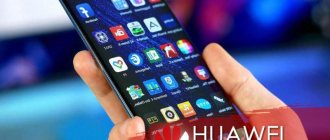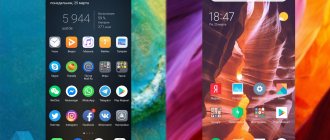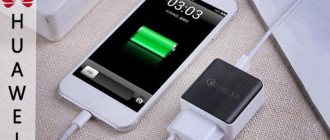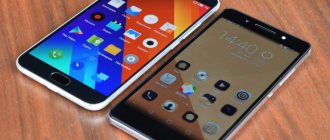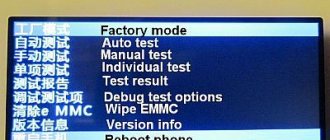When Huawei introduced Harmony OS for smartphones, everyone was sure that now it would become the only software basis for the brand’s proprietary smartphones. Still, it’s illogical to create internal competition and continue to support the Android shell when you have an entire operating system. But it turned out that Huawei had a different opinion on this matter, and it decided that it would continue to support EMUI.
Huawei introduced EMUI 12, but it’s not very clear why it’s needed
Despite the fact that Huawei is now actively distributing Harmony OS, today it officially introduced EMUI 12 . This is a new version of the company's proprietary shell, which is built on Android. That is, it turns out that Huawei plans to develop it in parallel with its own operating system, giving users the opportunity to decide for themselves what to install.
How to pay with Huawei and Honor phones using Mir Pay
Huawei did not announce which version of Android EMUI 12 is based on . But there is reason to believe that this is last year’s Android 11, and not Android 12. The fact is that Huawei does not have access to Android 12 , because it has not yet been released, and Google provides the source code for unreleased OS versions only to its partners. Huawei is not one of them, for obvious reasons, so it is content with the old iterations.
During its presence in the smartphone market, Huawei has not only learned how to make extremely competitive devices, which in recent years have consistently ranked among the top sales, but has also made great progress in creating software for them. It was customary to laugh good-naturedly at the proprietary shell for Android, Emotion UI, or, as it has long been abbreviated as EMUI, four years ago. Now no one laughs anymore. We are not talking about a system that is overloaded with not always necessary functions, a slightly student-designed system with a distinct Chinese accent, but about perhaps the best shell for Android, ideally tracking current trends in the world of software and even striving to stay ahead of the curve.
EMUI 10 was released simultaneously with Android 10 - and is intended specifically for smartphones with this operating system. It made its debut in Huawei devices on the Mate 30/Mate 30 Pro model, a full review of which has already been published on 3DNews. Here we will tell you in more detail about this interesting and well-executed shell.
The main difference between EMUI 10 and the previous version (EMUI 9) is a completely redesigned design.
The shell received a new “magazine” design code - many system screens are provided with indents along the edges, like pages of a magazine. The icons have been drawn anew - now they are made exclusively according to the golden ratio. Here we would like to make a note “a perfectionist’s paradise”, but perfect uniformity in the “default” theme cannot be achieved - system icons are invariably square with rounded corners, but some third-party applications are taken into a white square, and some are not for some reason. A new store of themes for the shell can save you, where you can find those that will bring all the icons to a common denominator.
The color code has changed: EMUI 10 uses the colors of the Morandi spectrum - due to this, the shell looks more delicate and fresh. At the same time, EMUI is immediately recognizable to everyone; the differences between the tenth version and the ninth are not noticeable.
The ability to display information on a locked display (Always-On Display) has been on Huawei smartphones for quite some time, but only in EMUI 10 they made a serious emphasis on it - the list of things displayed on the “off” screen has been expanded, fonts can change color depending on the time of day . You can also add small pictures there.
The notification shade has been redrawn - and yes, it has become much better. New icons, new pictograms, even the animation has improved.
The interaction with the icons has changed slightly - now they seem to “press” when touched, as if on a virtual spring, and this really adds tactility to interaction with the smartphone. Gesture control has been improved, its scheme has changed slightly: if you swipe left or right from the corner of the display, you will be sent to the previous screen; swipe up to exit the application; If you pull up from the bottom and hold your finger, a menu opens with all active applications. It is implemented very conveniently - I switched completely to gesture control without a navigation bar at the bottom of the screen without any problems.
Well, the most important visual change is that today’s obligatory dark theme has appeared, which looks great and allows you to significantly save energy on devices with OLED displays. Following the theme of the entire shell, all applications that have this option in their arsenal, like Instagram, also change their color.
Along with all the interfaces, the camera application has also been updated. However, there were no fundamental changes: both the control logic and the set of tools were approximately the same. But the fonts have been replaced - the Leica corporate style has disappeared - the overall style has become visually “lighter”, the icons have been simplified, and in night mode the countdown is carried out in numbers, and not using a descending circle. But the zooming mechanism - with the obligatory need to “pull” the icon, and not change the focal length with one touch on it - has become, on the contrary, more cumbersome.
The response time has decreased, the active use of neural networks also makes EMUI even faster (although no one complained about the smoothness of the system before), allows you to optimize software processes and ensure stable operating speed for a couple of years to come.
The most important internal change in the new shell is related to the introduction of Distributed virtual bus technology, which means that smartphones with EMUI 10 are completely ready to be combined with various devices into a single data exchange system with seamless switching. This is a foundation for the future, in which the proprietary HarmonyOS operating system will already be actively distributed.
Another echo of the same technology is the improved data exchange technology with Huawei OneHop laptops. Now you can not only transfer information in one motion, but also control your smartphone from the laptop screen.
EMUI 10 debuted on the new flagships Huawei Mate 30 and Mate 30 Pro, but an update to the latest version of the shell is planned on a number of the company’s smartphones that have been released for a long time. The following Huawei devices will receive it: Huawei P30 Pro, Huawei P30, Huawei Mate 20, Huawei Mate 20 Pro, Huawei Mate 20 RS, Huawei P30 lite, Huawei P smart 2021, Huawei P smart+ 2021, Huawei P smart Z, Huawei Mate 20 X , Huawei Mate 20 X (5G), Huawei P20 Pro, Huawei P20, Huawei Mate 10 Pro, Huawei Mate 10 Porsche Design, Huawei Mate 10.
Safety
With the advent of fingerprint scanners and the Face Unlock function even in budget smartphones, only the very lazy (and fearless) will use a smartphone without locking. EMUI allows you to further secure some files by moving them to “Personal” in Explorer and blocking the launch of certain applications.
The system file manager allows you to transfer any images, videos, audio recordings and files to “Personal” - they will be stored on the smartphone in encrypted form and can only be accessed by entering a password or scanning your finger in the corresponding section of the application. Application blocking works in a similar way - you can launch the selected program only after entering a code or scanning your finger.
Flagships VS state employees
99% of the features described above are available on all Huawei smartphones from the most affordable Y5 (2018) to the P and Mate series, but flagships offer even more. For example, devices with Kirin 970 (Mate 10, P20 Pro and P20) support desktop mode, when using a Type-C-HDMI adapter a “computer” interface is displayed on the external screen, in which you can run mobile applications in separate windows and thus assemble kind of like a mobile office.
Some functions are tailored to the NPU built into the processor - this is the Microsoft Translator, product recognition from photos with integration from Amazon, accessible from the system search, business card scanning for more convenient adding of new contacts, and more.
Instructions for installing the beta version of emui 10
And here we will tell you how you can “bypass” the beta version of the shell on your smartphone. Give it a test before Huawei engineers tweak it and offer you the opportunity to install a completely stable product. First, you will need to log in to your Huawei account. (Settings-Login via Huawei account) If it did not exist before today, you will have to create it. Your phone number or email address will be enough for this. Next, go to the application that appears there. Let's get acquainted with digital documentation. Tap on “acquainted” and “accept”. You are now a beta testing participant.
Next, go to the Huawei account menu in the personal section. We select the “join a project” tab there, and there is already “available project”. We are registering for beta testing. Then, if you did everything correctly, you will receive a notification on your smartphone that a new version of the shell is available. All that remains is to install what is offered and use it.
More about Huawei: Description of ways to configure VIBRATION on Android (enable | disable) 2019
To summarize, we can say that the new EMUI promises to be a very interesting solution in the smartphone market. Stylish enough to confidently “walk the catwalk” next to Android shells from Samsung, Xiaomi and Meizu. Smart enough to help you interact better with the programs you need.
Magazine style
Announcing the new interface at IFA 2021, the head of Huawei Consumers Group, Richard Yu, focused on the new design style, which in .
It refers to the aesthetics of printed magazines, in which headlines, text, and images are divided into structured blocks. At the same time, so that everything does not get mixed up, enough space is left between the layout elements. In terms of a smartphone interface, this is also important, as it allows you to more comfortably access interface elements.
The easiest way to demonstrate the new approach to design in EMUI 10 is using the settings menu as an example; it now has a larger header, the distances between elements have increased, and they themselves have become larger.
As a result, the menu became easier to navigate.
What problems can you encounter with EMUI 11?
One of the problems is various failures. Huawei representatives also say that after updating the OS, some of the downloaded add-ons will stop working. For example, banking utilities and instant messengers. In this case, “Error” will be displayed on the display. The problem concerns the optimization of the smartphone OS. The version is currently being tested in order to fix any problems in the future. There may also be problems with the games. After loading the screen begins to flicker. In this case, it is recommended to change the display resolution and start the game again.
How to install android 10 on honor and huawei smartphones
To make your phone more modern:
- find the HiCare utility on your desktop;
- click on it;
- go to "Quick Service";
- Next you need to find the tool responsible for the update;
- activate it with a checkmark or slider;
- then the system scans the information for about a minute;
- if there are updates, they will be displayed on the screen with a large “Update” or “Update” button;
- click on it.
The shell weighs between 4 and 5 GB, so check your storage for free space.
Camera design update
Changes in the design of EMUI 10 also affected the camera application, in which all elements have become flatter, the shutter button is larger, and the font for the shooting modes is larger.
Thus, the functionality of the camera has not changed, but the visibility of its interface has improved and it is more comfortable to use. But what the company has left the same is the location of the buttons that are responsible for switching cameras. They are located not next to the shutter button, but below, and when you shoot while holding the smartphone with one hand, it is quite difficult to reach them. I hope this will be changed in the next system updates.



